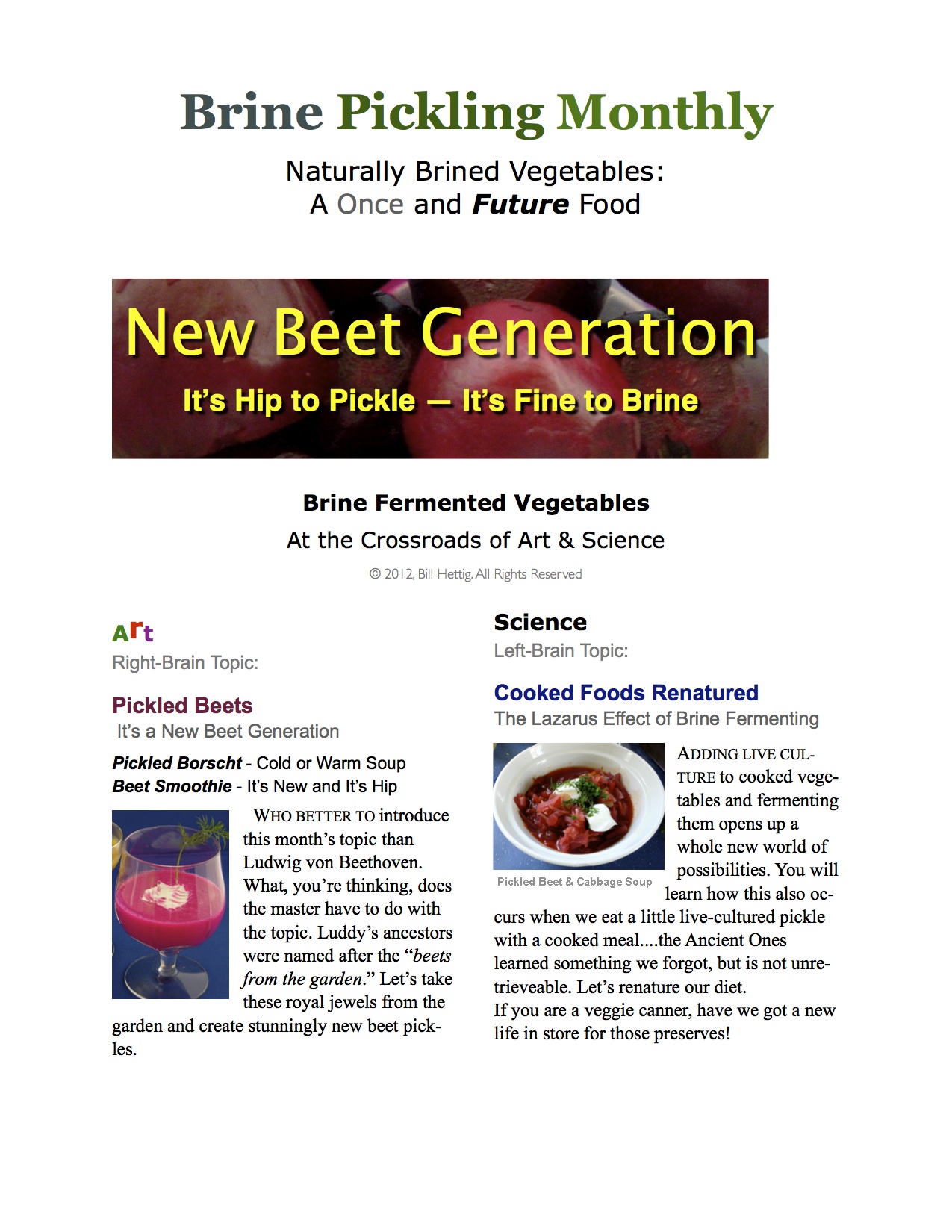
Science of Brine Pickling
Left-Brain Topic:
Cooked Foods Made Un-cooked?
Renaturing Produce through Brine Fermentation
Over my career I have found inspiration from people who had simple questions or insights in my cooking classes. Two students made me realize that the diets of the long-lived cultures show an exquisite balance of raw, cooked, and fermented foods. In countless ways these Ancient Ones have found ways to maintain good health by the ingenious techniques of renaturing their diet.
Renaturing Food - The Lazarus Effect
A couple years ago a rookie pickler asked me a question that I think will ultimately revolutionize the preserved food industry. Elizabeth wondered if she could brine ferment jarred pickles! She had trouble finding decent raw cucumbers and wanted to know if she could “pickle a pickle.” Eureka! It makes perfect sense when you consider that lactic fermentation—what drives brine pickling—does not care if the vegetable is cooked or raw. Just like making yogurt by first cooking the milk and then culturing it; you can do the same with canned vegetables.
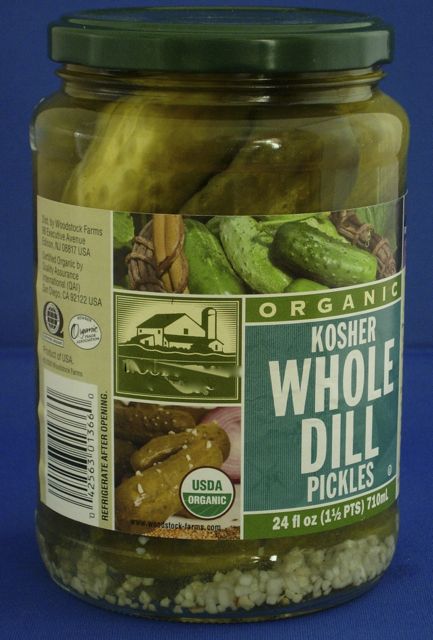
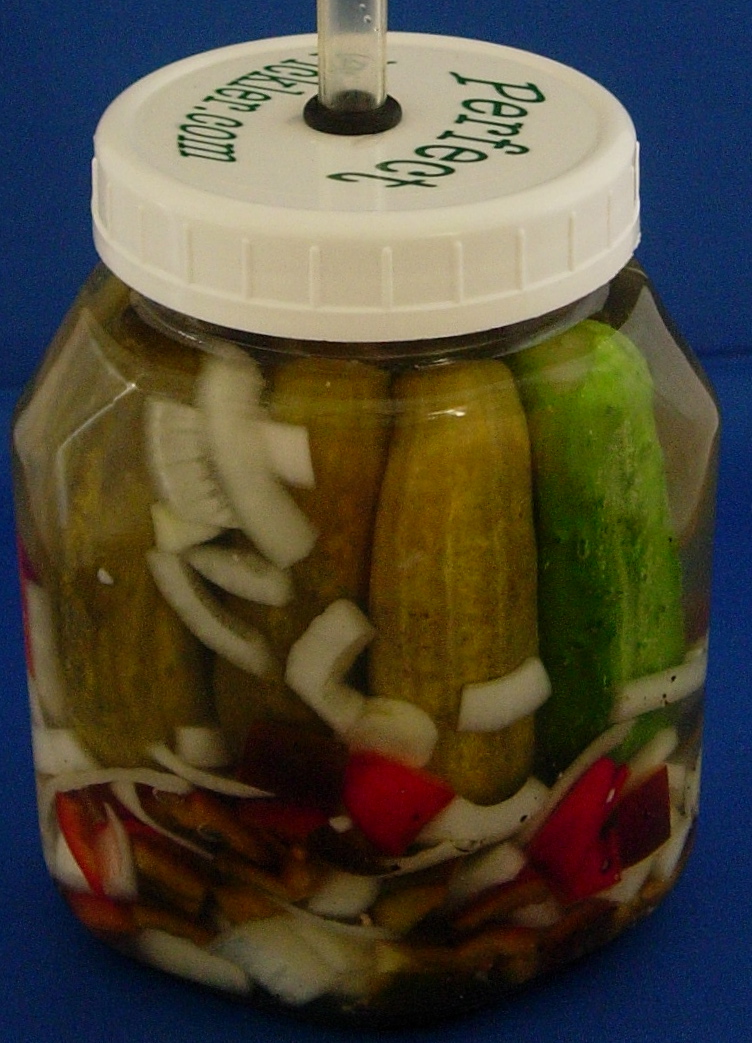 But would it work? I tested with a jar of organic dill pickles from off the shelf (Woodstock Farms Kosher Dill Pickles), soaked them in fresh water, then repacked them in the Perfect Pickler along with fresh onions, garlic, and sweet peppers. I made up a fresh brine and also added some aged brine (from a previous batch). I also included a raw cucumber to see how it pickled (far right; light green). It worked with great results. I tested the pH and the pickling had lowered the brine below 4.7 and I knew we had a successful test. And they tasted delicious for weeks into the test.
But would it work? I tested with a jar of organic dill pickles from off the shelf (Woodstock Farms Kosher Dill Pickles), soaked them in fresh water, then repacked them in the Perfect Pickler along with fresh onions, garlic, and sweet peppers. I made up a fresh brine and also added some aged brine (from a previous batch). I also included a raw cucumber to see how it pickled (far right; light green). It worked with great results. I tested the pH and the pickling had lowered the brine below 4.7 and I knew we had a successful test. And they tasted delicious for weeks into the test.
The New World of Old World Pickling
What does this portend? How can we benefit? Consider that fresh brine pickles need to be refrigerated after primary fermentation is complete. It’s not practical to refrigerate a harvest worth of pickled vegetables. But, what if we preserved them as always, using a hot water bath or pressure canner, and then turned them into renatured, fresh brine pickles on demand—by the quart—and by the recipe? All year long... This is the key to renaturing our highly refined diets. Here’s how:
Renatured Perfect Pickles
• Empty the contents of a quart of canned or jarred vegetables into a strainer. (If the canning liquid is water you can use this to make a fresh brine) Note: If you have pints or half-gallon jars adjust the amounts below.
• Mix in about four cups of raw vegetables—primarily onion, garlic and other raw root veggies, and peppers (exclude red peppers—they’re too ripe)
• Spice it up with a blend of choice—like Italian, curry, jerk, chili, or a homemade blend
• Place all in a large bowl and toss
• Make a fresh brine (page 8, Step 1 in instruction booklet) and add 4 TBS. of aged brine
• Pack the mixture into a 2-quart jar or two 1-quart jars (in two jars you can have different spice blends)
• Pour in the brine until almost full
• Screw on the Perfect Pickler top assembly according to instructions on page 8 to complete
• In four days or so, you have renatured, live-culture, enzyme-rich pickles
Become renatured brine picklers as gardeners, canners, and grocery shoppers who can’t find fresh vegetables.
We have a top rated renatured recipe on our website: Pickled Lazarus Beets. It is a classic sweet and sour recipe that will not disappoint.
The Finnish Insight
The second inspiration came from a first-generation New World emigree. During a class on cultured foods, Lorraine raised her hand and offered up that in Finland they always ate a little something pickled when eating their meal— “to help digest the cooked food.” It was an aha! moment. This helped explain why world cuisines heavy with refined and cooked ingredients, like white rice and noodles, could still yield a healthy diet. These folks were chewing enzyme-rich, probiotic dense foods right into the cooked food with every chew and renaturing it. This is done by the extraordinary action of enzymes from both raw and fermented foods—like brine pickles—each bite is renatured at blinding speed even before it is swallowed.
First, a quick primer in enzymes and friendly bacteria is in order...
Without enzymes, body functions would be too slow to sustain life. Enzymes are essential, and each person is born with a limited enzyme potential. So maintaining an adequate outside supply is vital in supporting body health. When food enzymes are destroyed by cooking the body must use their own to digest the meal. Therefore, one of the best ways to help maintain a healthy supply of enzymes is to eat culture-active foods which will ensure a surfeit of enzymes to produce superior digestion. For speed, the enzyme carbonic anhydrase acts on 600,000 molecules per second!
Bacteria have no digestive tracts. Instead, they secrete enzymes to break down the food with high-speed efficiency. When you consume culture-active foods, these microbes and their enzymes are in massive quantities. When you consume them you are practicing the digestion of the Ancient Ones. Your food quickly breaks down and becomes more digestible. You may eat, and chew, and swallow, but the cells— over 100 trillion of them—may not get enough of your meal if it’s all cooked or without enzyme rich support. When you combine culture-active foods with every meal, you boost your enzymes and your ability to feed at the molecular level.
Japanese, the longest-lived people in the world, eat pickles at every meal. Koreans consume quantities of pickled vegetables, known as kimchi—their national dish—with every meal. Mediterraneans add cultured cheeses to their grains and pastas. In future newsletter issues we will explore other cultures who live long lives by consuming enzyme rich, pickled foods.
Enzyme Benefits:
• Hyper-speed of enzymatic activity rapidly converts food into nourishment
• Enzymes pounce on hard-to-digest foods
• Digestive enzymes act as macro digesters insuring more complete absorption of vitamins and minerals
• The most direct way each cell will revitalize itself and thereby give you vitality is to ensure enzymes break our food down completely into ionic form, and create a perfect meal for each cell
• To continue to eat large portions of processed foods; distilled of enzymes will have long-term impact on your digestive tract and your ability to revitalize.
• During any meal consider how much cooked food you have and balance with raw food and cultured foods, like fresh brine pickles.
______________________________________________________________
Art of Brine Pickling
Right-Brain Topic:
Pickled Beets It’s a New Beet Generation
Pickled Borscht - Old Soup - Souped Up
Beet Smoothie - A Pickle That’s Hip to Sip!
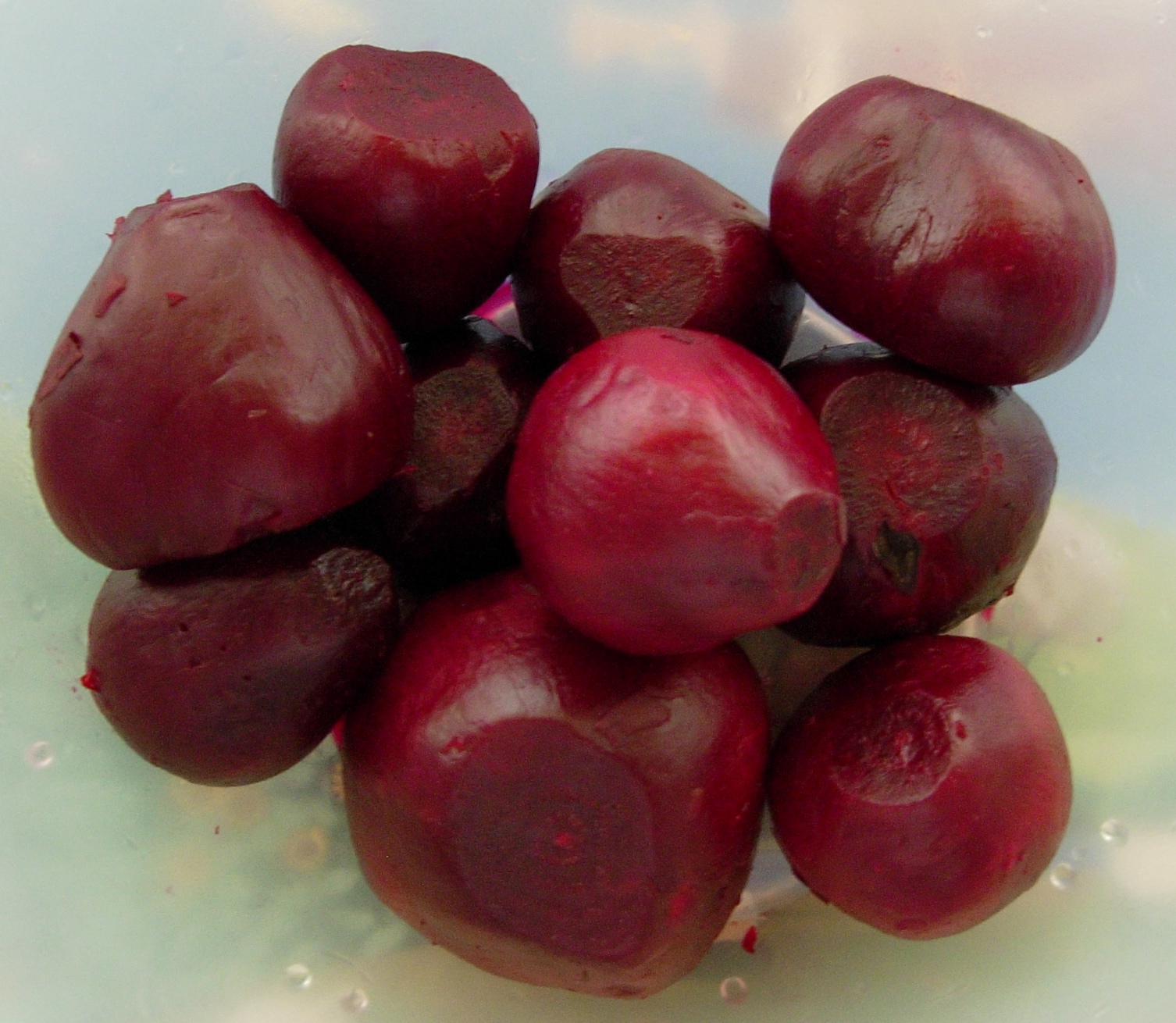 Beets are a key Old World vegetable known for their beauty, their value—both root and tops are meal worthy—and their sweetness. To my way of thinking they are underutilized darlings in New World cuisine.
Beets are a key Old World vegetable known for their beauty, their value—both root and tops are meal worthy—and their sweetness. To my way of thinking they are underutilized darlings in New World cuisine.
One of the great recipe combinations to come out of the melding of Eastern European cultures is borscht—beet and cabbage soup—rarely served on this side of the Pond. Famed as a mainstay in Jewish Delis, it can be served hot or cold, vegetarian, or with meat. It has a hauntingly simple balance of flavors. I love that it is found within such humble garden crops. I will show you a way of remaking this primal soup.
My twist is to first ferment it before serving it cold on a hot day; or as a warm soup on a cold day. Like Spanish gazpacho soup, it can be delicious as a cold chunky soup or a puree.
Ta-dah!! How about a smoothie! I have served this as a stand up party appetizer in brandy glasses. And to make this a swift and easy recipe, we’re going to use prepared stock and cooked beets. Employing the power of fermentation we will renature our soup in just four days. (I also have a borscht recipe using all raw ingredients, you can email me at: bill@perfectpickler.com).
Prepping Beets for Pickling
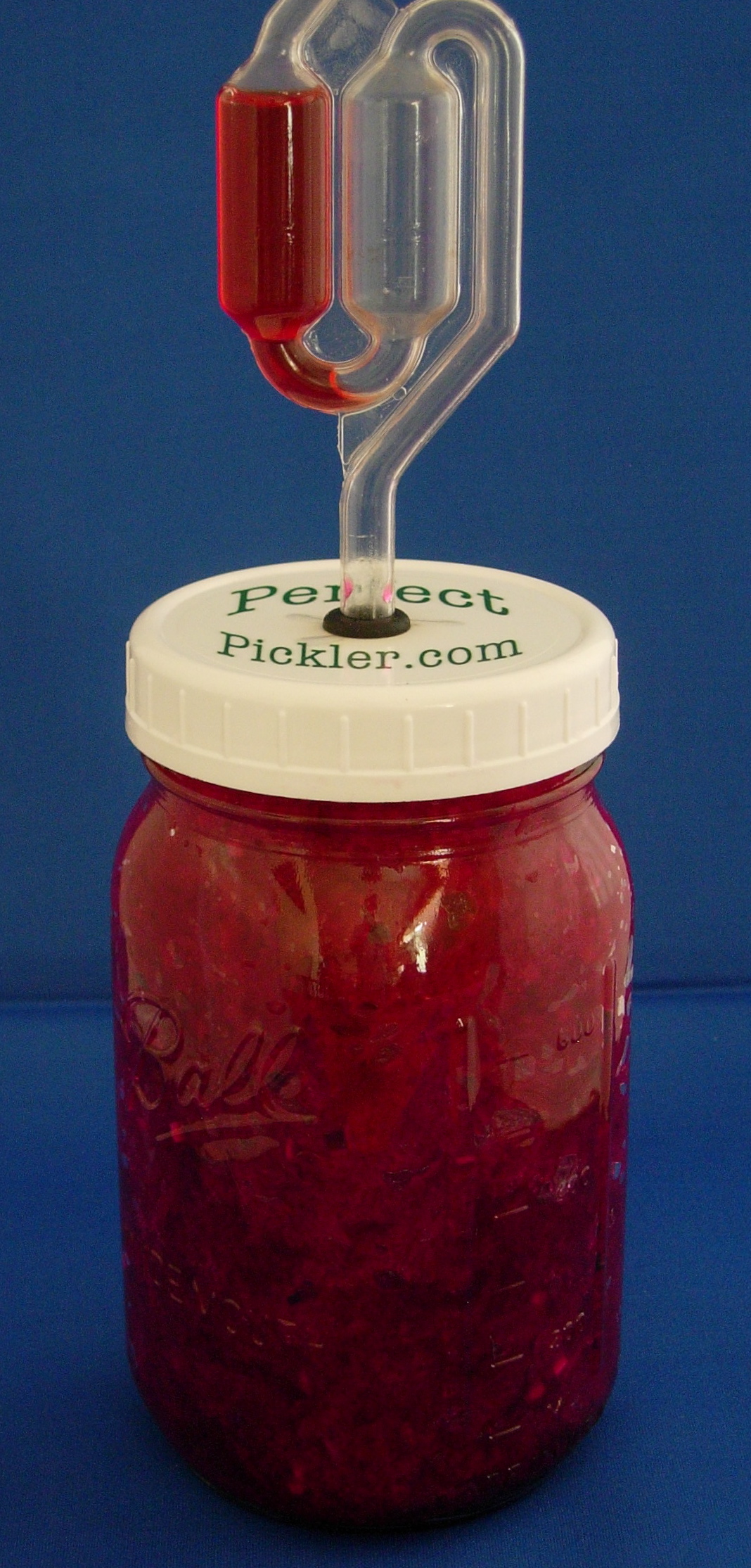 After pickling raw beets in a variety of shapes and textures, I find coarsely grated offers the best mouthfeel. Microbes can’t easily convert large chunks of raw beet. Most American palates are fond of cooked, sweet-sour pickled beets. These in fact are cooked and pasteurized in the jar and sold in the dry goods section—lacking live culture and enzymes. You can make a lovely, AND live-culture version. Find Lazarus Pickled Beets in our recipe section on the website. Be ready for some red color on and around your hands and cutting board. There are now non-bleeding varieties of beets, although at a premium. Golden and Candy Cane varieties show off gorgeous colors in any soup or salad presentation.
After pickling raw beets in a variety of shapes and textures, I find coarsely grated offers the best mouthfeel. Microbes can’t easily convert large chunks of raw beet. Most American palates are fond of cooked, sweet-sour pickled beets. These in fact are cooked and pasteurized in the jar and sold in the dry goods section—lacking live culture and enzymes. You can make a lovely, AND live-culture version. Find Lazarus Pickled Beets in our recipe section on the website. Be ready for some red color on and around your hands and cutting board. There are now non-bleeding varieties of beets, although at a premium. Golden and Candy Cane varieties show off gorgeous colors in any soup or salad presentation.
Pickled Ruby or Golden Borscht - Makes 2 Qts.
It’s a soup, it’s a pickle, it’s sour, it’s sweet-sour—it’s a pickler’s best friend
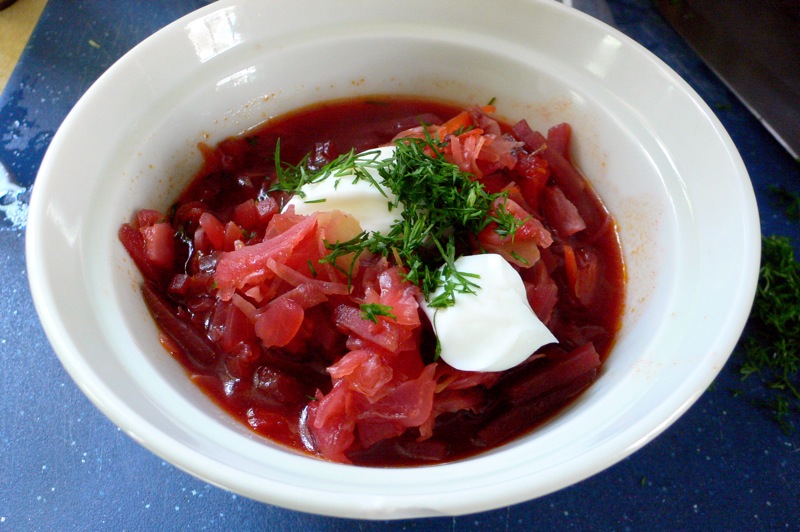 My quick version of this Polish style (barszcz) is cooked, then fermented, and finally served cold or warm. Rather than add a vinegar or lemon juice at the end, fermenting the soup gives the tart balance. This recipe transcends its cool nature with a back-of-the-throat richness. Great summer and fall marriage of beets and cabbage. - Recipe by B. Hettig © 2012
My quick version of this Polish style (barszcz) is cooked, then fermented, and finally served cold or warm. Rather than add a vinegar or lemon juice at the end, fermenting the soup gives the tart balance. This recipe transcends its cool nature with a back-of-the-throat richness. Great summer and fall marriage of beets and cabbage. - Recipe by B. Hettig © 2012
This pickle recipe requires a larger percentage of brine than traditional beet pickles. The extra brine creates the broth for the soup.
cabbage 2 cups finely shredded (reserve two leaves
to use to complete sealing the jar)
vegetable stock 4 cups low sodium, organic is a good choice
sea salt, unrefined 1-1/2 TBS. coarse, or 1 TBS. fine ground
beets, canned 4-15 oz. cans unsweetened, rinsed, then shredded
onion, raw 1 cup sweet onion, finely minced or shredded
garlic, raw 3 large finely minced or pressed
peppercorns 1 tsp. lightly cracked or coarsely ground
aged brine 1/4 cup [opt.], from previous batch of pickles
After Fermentation serve topped with:
sour cream or nut cream
fresh dill, or parsley
fresh tomatoes, finely diced
pepper
If serving as a warm soup and to keep the culture-active, warm to no more than about 110 degrees.
For a version using your own raw beets, see bottom of recipe section
1 Open canned beets and drain off liquid, rinse beets and drain.
2 Start heating the stock. Meanwhile, shred the cabbage and place in the stock and simmer about two minutes, to soften. Add the salt. Cool stock and cabbage.
3 Meanwhile, shred the onions and place in a bowl with a cup of water and a TBS. of vinegar and let soak for 5 minutes, then drain. Mince the garlic. Place beets, onion, garlic in a large bowl. When brine-cabbage is cool, add to the beet mixture and toss to combine.
4 In a 2-quart, clean jar add peppercorns and brine from a previous batch of brine fermented pickles (if using.)
5 Fill the jar with beet mixture, lightly tamping until you get to 3 inches from the jar lip. Pour in the stock until it just covers the mixture. Reserve and refrigerate extra brine to use later when thinning soup to serve.
6 Go to directions on page 9 of instruction booklet or the kraut/slaw video on our link > How It Works to complete sealing the Perfect Pickler.
(If cooking your own raw beets, peel and shred, then simmer along with the shredded cabbage in vegetable stock until softened-about 5 minutes. Then cool.) Then proceed to step 3.
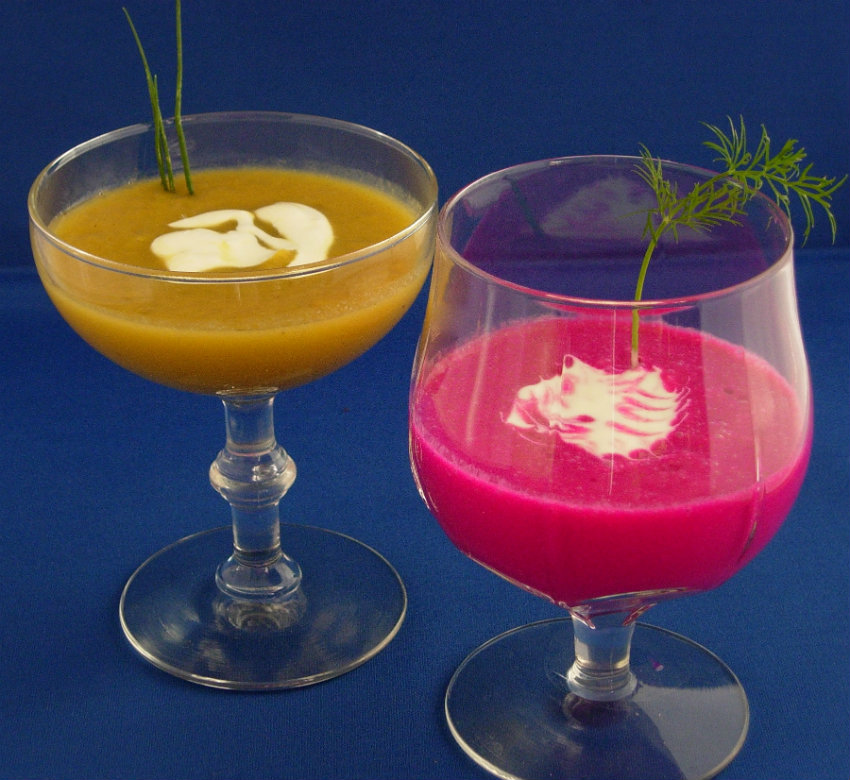 Beet Smoothie
Beet Smoothie
This is a great beverage for people on the go. Just like a fruit smoothie you can whip up a chilled meal or snack in minutes. I came across an article in the NY Times that updated the presentation of borscht by blending and serving in fancy glasses. Put equal amounts of chilled beet mixture and broth and combine into a blender with an ice cube. (I like blenders with small single serving sealed jars, like Tribest, or Bullet). Also consider a stick or immersion blender. If your blender does not puree finely enough, pass through a fine strainer. Serve as a chilled soup or in glass with dollops of sour cream or nut cream, top with dill or chive garnish. This wants to be ice cold at serving time.
Note: You can make an all raw version—the results will be crunchy (and delicious). Use peeled raw beets and shred finely. Omit simmering the brine and omit using the aged brine.
By soaking prepared onions in a vinegar solution, you take some of the bittery bite out. This is a good technique for all pickling recipes. B.H.
